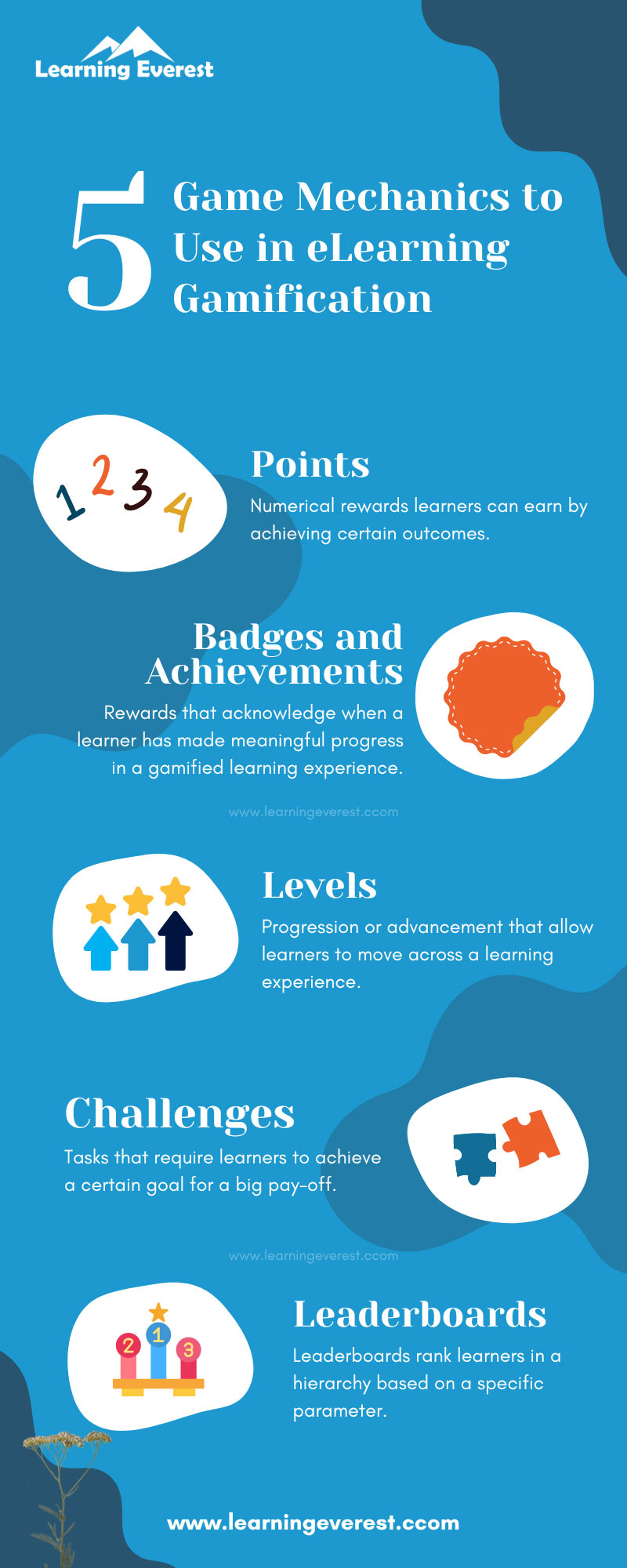Gamification is the use of game mechanics and elements in a non-game environment. This strategy makes digital experiences more exciting and engaging. One area where gamification is used commonly is eLearning.
Table of Contents
A lot of eLearning is gamified to make the learning experience more impactful and interesting for learners. This article will go over some of the most commonly used game mechanics in eLearning and demonstrate them using gamification examples.
Here are five Game Mechanics to Use in eLearning with Gamification Examples
1. Points
Points are numerical rewards learners can earn by achieving certain outcomes. These outcomes vary from course to course, and are influenced by the treatment, goal, and structure of the course.
Points motivate learners to perform better and add stakes to the learning experience. This is true for most game mechanics used in eLearning gamification.
Gamification Examples
Gamification examples for points are incredibly diverse due to the simplicity of this mechanic. Here are some examples:
- In a microlearning course on vocabulary, learners gain 1 point for accurately translating an English word into the target language.
- In a gamified science quiz, learners gain 2 points for correct responses but lose 1 point for incorrect responses.
2. Badges and Achievements
Badges and achievements acknowledge when a learner has made meaningful progress in a gamified learning experience. They reinforce the learner’s efforts and give them a sense of satisfaction for how far they have come.
They can be offered at different kinds of milestones, such as completing a quiz, completing a chapter, collecting a certain number of points or collectibles, etc.
Gamification Examples
Some examples of badges and achievements being used in eLearning are as follows:
- In a course about surgical instruments, learners gain an achievement and forceps badge after unlocking all kinds of forceps used in surgery.
- In a 12-module certificate course, learners gain an achievement on the completion of 3 modules, ranging from “Beginner” to “Master.”
- In a test on musical aptitude, learners gain different badges based on their ability to accurately distinguish between beats and pitches.
3. Levels
Levels are a great way to structure a course from simple to complex, allowing learners to build solid foundations and connect them to more advanced learning effortlessly.
Apart from structuring courses, levels add a progression system to learning experiences, making them more engaging. Learners can anticipate and celebrate progression with level-based learning experiences. Additionally, levels allow learners to customize their learning journeys by picking up at a stage that fits their knowledge level, saving them time and effort.
Gamification Examples
Let us look at some gamification examples that use levels:
- A gamified acting module on body language is divided into 3 levels – extra, sidekick, and main character.
- A fast-food assembly course with vertical levels. The simplest dish is taught at level 1 and the complexity of each dish increases as the levels progress.
- A board-game based course on personal finances with different sections on the board divided by levels ranging from “Zero Savings” to “Comfortable on A Rainy Day.”
4. Challenges
Challenges are tasks that require learners to achieve a certain goal for a big pay-off. These tasks are often less straightforward than typical learning activities and push learners to use their critical thinking and problem-solving skills.
Challenges build learners’ confidence and create a sense of satisfaction and achievement.
Gamification Example
Here are some gamification examples involving challenges:
- Learners are required to identify and click on all animal pictures in a collage within 45 seconds.
- Learners need to finish a quiz with only 2 incorrect responses, getting more than 2 incorrect responses will automatically lead to a “loss.”
- Learners need to pick the correct response options in a conversation-based scenario to keep the listener’s mood meter at happy.
5. Leaderboards
Leaderboards rank learners in a hierarchy based on a specific parameter. They foster healthy competition and greatly improve learner motivation to push their limits.
Leaderboards also add a social element to learning, where learners can encourage and motivate each other with virtual support such as likes, messages, gifts, etc.
Leaderboards are typically seen in LMSs instead of within actual courses, due to how authoring software functions.
Gamification Examples
Some examples of leaderboards include:
- An intra-team leaderboard for who has completed the most compulsory training modules within a 3 month period.
- A cohort leaderboard for language learners which shows who has the most correct responses on a daily quiz.
- An intra-classroom leaderboard that shows who completes the most hours of online self-study each week.
Conclusion
These gamification examples show that gamification can be incorporated into eLearning very meaningfully to improve learners’ engagement and motivation. Gamification freshens up learning experiences and shifts the focus from passive learning to active, participation-based learning. It is also worth mentioning that multiple game-elements are often used together in a course. For instance, a course might use points, achievements, and levels. eLearning gamification is a versatile and flexible training strategy which only requires that you match the training need well with your choice of gamification.
Infographics

Game Mechanics to Use in eLearning Gamification
Knowledge Check!
Frequently Asked Questions (FAQs)
What is eLearning gamification?
eLearning gamification is the use of game mechanics and elements in an eLearning environment.
What are the game elements used in eLearning gamification?
Some commonly used game elements in eLearning gamification are:
- Points
- Badges and achievements
- Levels
- Challenges
- Leaderboards
What are some gamification examples seen in eLearning?
eLearning has a plethora of gamification examples to offer. Here are some:
- Awarding points for correct answers on a quiz
- Awarding badges for meeting certain milestones
- Dividing learning journeys into levels
- Creating challenging tasks with big pay-offs
- Creating leaderboards based on specific parameters





